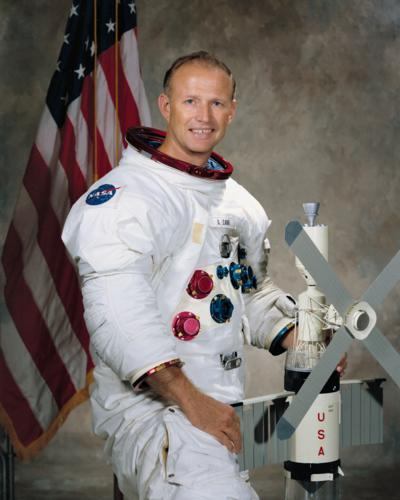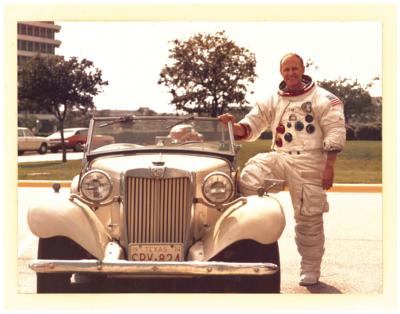Carr Commanded The Last Skylab Mission
Former astronaut Gerald Carr, who commanded the last Skylab mission, passed away Aug. 26, 2020 in Albany, NY.

“NASA and the nation have lost a pioneer of long duration spaceflight," said NASA Administrator Jim Bridenstine. "We send our condolences to the family and loved ones of astronaut Gerald 'Jerry' Carr, whose work provided a deeper understanding of life on Earth and in space."
As commander of the Skylab 4 mission, Carr and his all-rookie crew conducted a remarkable science program that included a wealth of biomedical investigations designed to test the effects of long duration spaceflight on the human body, Earth observations associated with the Earth Resources Experiment Package (EREP), and solar observations from instruments mounted on the Apollo Telescope Mount (ATM) revolutionized our understanding of the Sun.
At the conclusion of the Skylab program, Carr turned his attention to work on the nascent Space Shuttle Program. He applied his experience in space inform the shuttle cockpit design and the importance of considering human factors. Through long duration spaceflight, he said, “We began to realize the importance of the relativity of the human to the piece of machinery you're working with and what the weightless environment does to your skeleton and affects the way you do your work.”
Those contributions were pivotal to NASA’s ability to support humans living and working in space long term.
Carr was born Aug. 22, 1932 in Denver, Colorado. He joined the Navy in 1949 and one year later received an appointment to the midshipman (NROTC) program. He received a Bachelor of Science degree in mechanical engineering from the University of Southern California in 1954 and aeronautical engineering from the U.S. Naval Postgraduate School in 1961. Carr completed his education by earning a Master of Science degree in 1962 from Princeton University. In 1976, Carr was presented with an honorary doctorate in aeronautical engineering from Parks College of Saint Louis University, Cahokia, Illinois.
Following flight training at Pensacola, Florida and Kingsville, Texas, Carr served as a Marine test pilot logging more than 5,300 hours of jet flying time on aircraft including the F-9, F-6A Skyray, and F-8 Crusader.
In April 1966, Carr was selected as a member of new 19-member astronaut class. His experience during the Apollo program included Capcom duties during the Apollo 8 and Apollo 12 missions. Carr was acting as Capcom for Apollo 12 when the Saturn V was struck by lightning during launch.
Skylab 4, the final crewed mission to the station, launched from Kennedy Space Center Nov. 16, 1973. Carr later recalled that the “launch went off perfectly. It was a beautiful, clear day. I remember when the escape tower was finally kicked off and it took the shroud with it, the light that came in the cabin was just blinding for a minute. It was incredible. I tell a lot of people that riding on a booster like that is kind of like riding on a train with square wheels. You've got lots of noise, lots of vibration, and all that sort of thing. Then sure enough, when you hit that first booster shutdown and staging and then the next booster kicking off, it's just exactly what everybody has called it: a train wreck. I just thought that was very apt.”

The Skylab 4 mission continued the work of the previous two crewed missions including biomedical research, Earth observations associated with the Earth Resources Experiment Package (EREP), and solar observations from instruments mounted on the Apollo Telescope Mount (ATM). One particular highlight of the mission was the seven-hour EVA (extravehicular activity) conducted with with Bill Pouge on Christmas Day, 1973.
After spending 84 days on orbit, the crew returned to Earth on Feb. 8, 1974. When asked in 2000 what he considered to be the greatest contributions of Skylab 4, Carr argued that it was the “medical stuff” stating that the crew had indeed “ proved, I think, just absolutely positively that the human being can live in weightless environment for an extended period of time.”
Carr’s retirement from the NASA astronaut corps in 1977 marked the beginning of another career, that of professional engineer. Along with his wife Patricia Musick, Carr founded a small aerospace consulting company, CAMUS Incorporated, in 1984. One of the company’s primary jobs was working on the development of crew systems for the International Space Station. Carr and his team educated engineers about weightlessness its effects on the ability of astronauts to interact with hardware on orbit.
Over his illustrious career, Carr was the recipient of numerous awards including the Robert J. Collier Trophy (1973), the NASA Distinguished Service Medal (1974), and the Robert H. Goddard Memorial Trophy (1975).
 ANN's Daily Aero-Term (04.24.24): Runway Lead-in Light System
ANN's Daily Aero-Term (04.24.24): Runway Lead-in Light System ANN's Daily Aero-Linx (04.24.24)
ANN's Daily Aero-Linx (04.24.24) Aero-FAQ: Dave Juwel's Aviation Marketing Stories -- ITBOA BNITBOB
Aero-FAQ: Dave Juwel's Aviation Marketing Stories -- ITBOA BNITBOB Classic Aero-TV: Best Seat in The House -- 'Inside' The AeroShell Aerobatic Team
Classic Aero-TV: Best Seat in The House -- 'Inside' The AeroShell Aerobatic Team Airborne Affordable Flyers 04.18.24: CarbonCub UL, Fisher, Affordable Flyer Expo
Airborne Affordable Flyers 04.18.24: CarbonCub UL, Fisher, Affordable Flyer Expo




